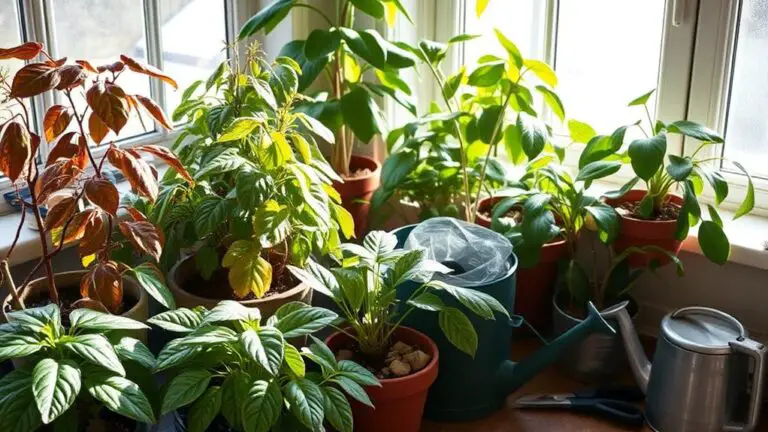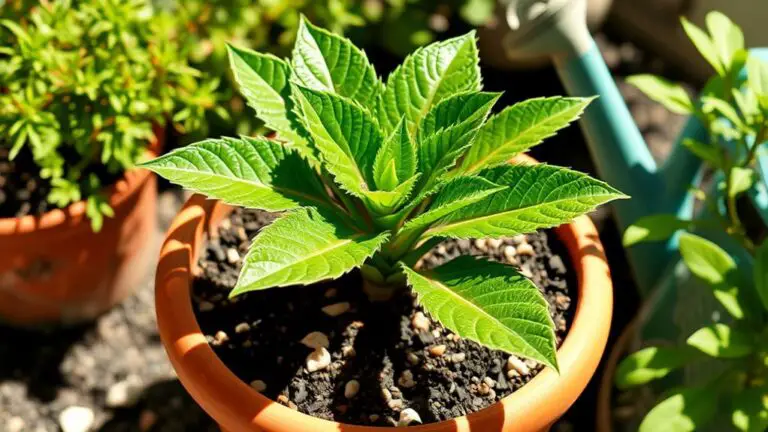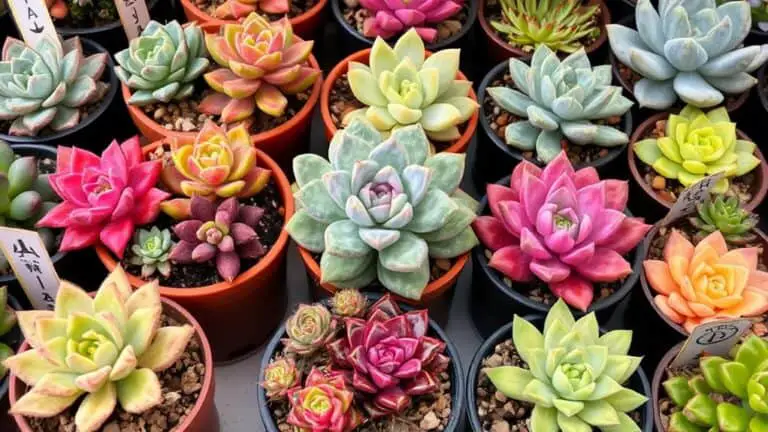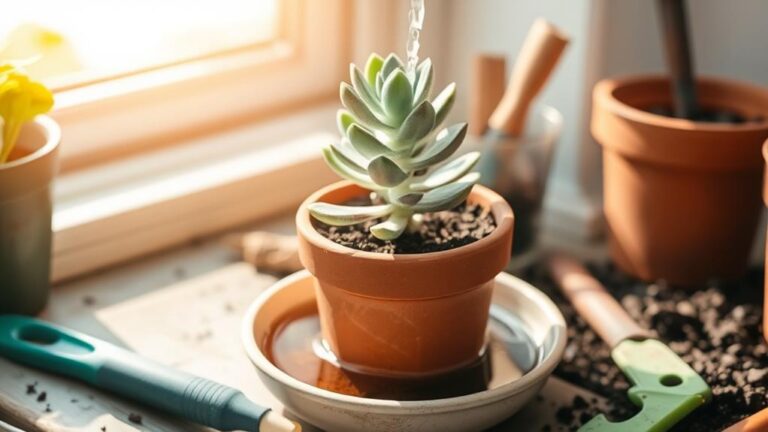7 Steps to Trim Succulent Roots and When to Do It
Trimming succulent roots is vital for their overall health, especially if you're dealing with root rot or a root-bound plant. You'll need to start by evaluating the root health and gathering the right tools like clean scissors and fresh potting soil. Gently removing the plant from its pot lets you inspect and clean the roots before trimming any damaged sections. But how do you make certain you're not harming the plant further? And what's the best way to promote recovery after trimming? Let's explore these essential steps together to keep your succulents thriving.
Assess Root Health

When evaluating your succulent's root health, you'll want to pay close attention to the appearance and texture of the roots. Healthy roots should look firm and white, signaling they can absorb nutrients properly. If you see mushy, blackened, or discolored roots, it's a sign of root rot. Root rot can spread quickly, so it's essential to address these issues promptly.
Drooping leaves and discoloration are often signs of root problems. They suggest that the roots may be unhealthy or struggling. Sometimes, a succulent becomes root-bound, which means the roots have outgrown the pot. You'll notice roots protruding from the drainage holes and a solid mass around the root ball. This situation requires trimming to give the roots space to grow.
Regularly checking your succulent's roots can prevent severe problems. Slow growth might indicate dead or obstructive roots. By evaluating and trimming these roots, you can enhance your succulent's overall health.
Gather Necessary Tools
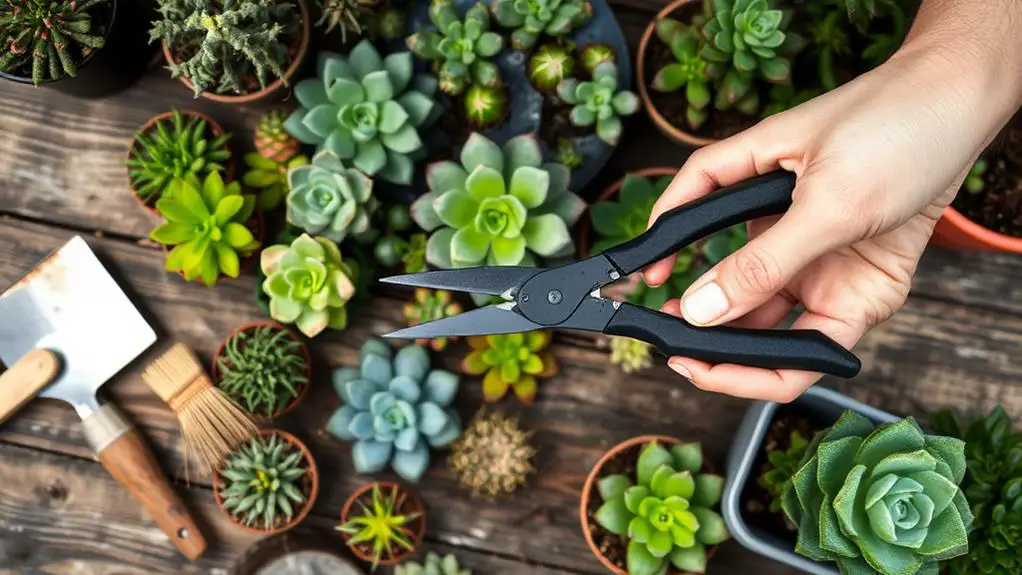
To successfully trim your succulent's roots, you'll need a few essential tools. First, gather a clean knife or sharp scissors. These will help you make precise cuts and reduce the risk of infection. You don't want to harm your plant with a dull blade. Next, have a light brush or soft cloth ready. This will help you gently remove old soil from the roots without causing any damage.
Be certain to have a clean pot or container with drainage holes if you plan to repot your succulent after trimming. Good drainage is key to keeping your succulent healthy. Don't forget your gloves! They're especially important if you're handling toxic succulent varieties. Finally, keep some fresh, well-draining potting soil on hand. This will provide the ideal environment for your succulent's recovery.
Here's a quick checklist to help you gather necessary tools:
| Tool | Purpose | Emotion |
|---|---|---|
| Clean knife/scissors | Ensure precise cuts, reduce infection risk | Confidence |
| Light brush/cloth | Gently remove old soil | Care |
| Clean pot/container | Provide drainage for repotting | Preparation |
| Gloves | Protect your hands | Safety |
| Fresh potting soil | Aid in succulent recovery | Support |
With these tools, you're ready to trim your succulent's roots confidently and effectively.
Remove Succulent From Pot

To remove your succulent from its pot, gently tap the sides to loosen the soil and roots.
Use a clean knife or trowel to carefully loosen the soil around the edges.
If the plant is root-bound, you may need to gently twist it while being careful not to pull on the leaves or stems.
Easing Plant Extraction
Gently tapping the sides of the pot loosens the soil and roots, making it easier to remove your succulent without causing harm. Start by holding the pot securely and tapping it on a hard surface. This action helps to free any root-bound areas where the roots have tightly wrapped around the soil. If your succulent's roots are especially tangled, this step is essential.
Next, take a clean knife or trowel and carefully run it along the edges of the pot. This helps to further detach the roots from the sides, ensuring that the plant comes out smoothly. Be gentle to avoid cutting into the roots or damaging the plant.
After loosening the edges, tilt the pot at an angle and give it a gentle shake. This motion helps dislodge the root ball from the pot. If the succulent is still stuck, don't force it. Check the drainage holes; sometimes roots grow through them. If this happens, use scissors to cut away any visible roots.
Throughout this process, handle your succulent with care. Avoid breaking off stems or leaves, as this can affect the plant's health. With these steps, you can extract your succulent safely and prepare it for the next stage.
Soil Loosening Techniques
When it comes to loosening soil and removing your succulent from its pot, a few simple techniques make the process smoother. First, gently tap the sides of the pot to break the soil's grip on the succulent roots. This helps to loosen the soil and makes it easier to detach the plant.
If the soil still feels tight, use a clean knife or trowel to carefully slide around the edges of the pot. This will detach any roots clinging to the sides, giving you more room to work.
For plants that are root-bound, try tipping the pot upside down while supporting the base of the plant. Gravity will help you pull the succulent out without damaging it.
If the succulent is stubborn, gently squeeze the pot to compress the soil and loosen the root ball further. Always handle the succulent carefully to minimize damage to the roots and guarantee a successful replanting.
Check for dead roots once the plant is out and trim them away.
These soil loosening techniques will make removing your succulent from its pot much easier. Remember, gentle handling is key to keeping your plant healthy and ready for its new home.
Clean and Inspect Roots
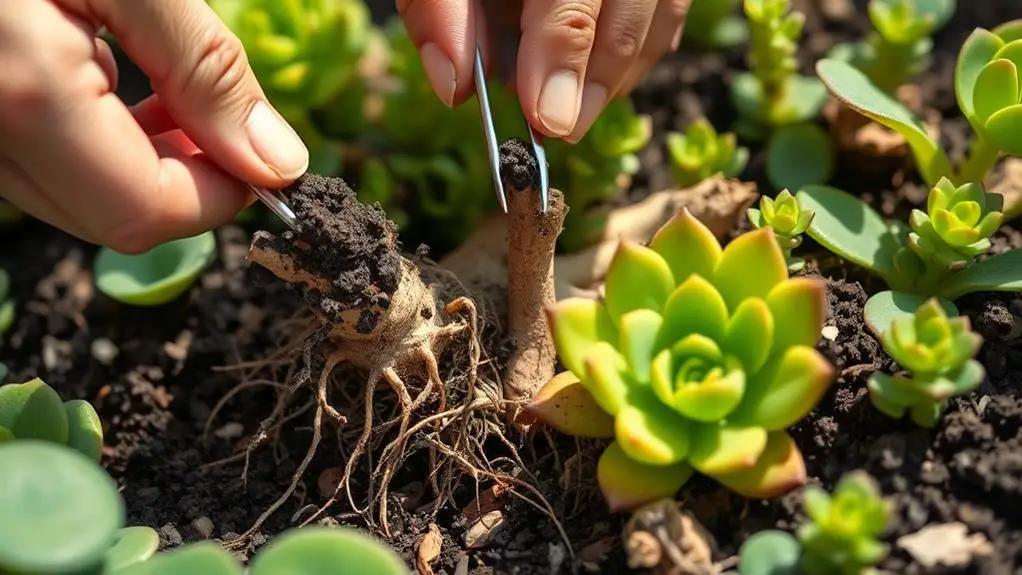
Start by carefully lifting your succulent out of its pot, making certain you loosen the surrounding soil to avoid damaging the roots.
Once the plant is free, gently brush off the old soil from the roots. This will help you see the roots clearly and allow for a thorough inspection.
Next, make sure to inspect for root-bound conditions. Root-bound succulents have tightly tangled roots or roots growing out of the pot's drainage holes. These conditions can restrict growth and need to be addressed.
Look for healthy roots that are firm and white. Healthy roots indicate that your succulent is in good condition.
While inspecting, check for any signs of damage or infection. Damaged roots might appear mushy, blackened, or discolored, which can be signs of root rot.
If you find any of these unhealthy roots, you'll need to take further action to guarantee the plant's health.
Trim Damaged Roots
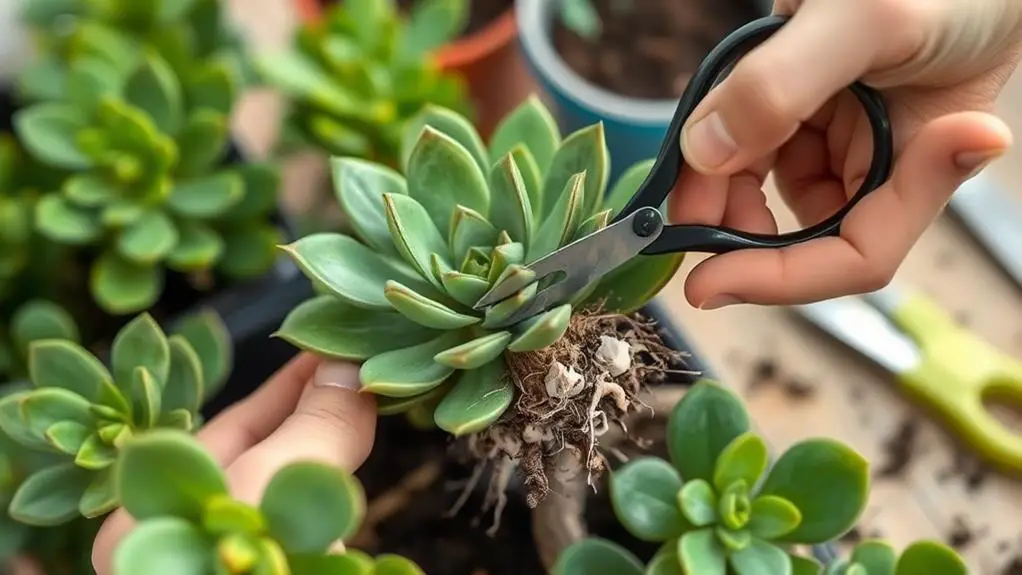
How do you guarantee your succulent thrives after discovering root damage? First, you need to trim the damaged roots as soon as you spot signs of root rot, such as mushy or blackened areas. This is the main reason to trim your succulent's roots—removing these infected parts prevents the rot from spreading and harming the entire plant.
Use clean, sharp scissors or a knife to make precise cuts. Carefully cut away all the infected roots, but make sure you leave at least two-thirds of the healthy roots intact. This balance is vital for the succulent's recovery and continued growth.
While trimming, also remove old, unproductive roots. These roots hinder nutrient absorption and the overall growth of your succulent. By focusing on these areas, you're helping your plant get the best chance at thriving.
After you've trimmed the damaged roots, allow them to dry for 1-2 days. This drying period promotes healing and prevents further rot.
Regularly check for damaged roots, especially in slow-growing succulents. This regular maintenance keeps the root system healthy and encourages stronger growth. By following these steps, you'll help your succulent flourish.
Dry and Repot Succulent

Allowing your succulent's roots to dry is crucial after trimming. Place your succulent in a shaded area for 1-2 days. This drying period helps prevent rot. Once dried, it's time to repot.
First, choose a new pot with drainage holes to avoid water buildup. Fill it with fresh, well-draining soil. This guarantees the roots don't sit in old soil, which might harbor pests or diseases. Carefully place your succulent in the center of the pot. Spread the trimmed roots gently to avoid tangling. This step is essential for encouraging healthy growth.
Emotional Journey:
| Step | Feeling | Outcome |
|---|---|---|
| Drying Roots | Patience | Prevents root rot |
| Choosing Pot | Excitement | Fresh start |
| Fresh Soil | Assurance | Healthy environment |
| Repotting | Carefulness | Proper root placement |
| Light Watering | Relief | Settles the soil |
After repotting, water the succulent lightly. This helps settle the soil around the roots. Be careful not to overwater, as this can lead to root rot. Keep an eye on your succulent in the following weeks. Watch for signs of stress, like wilting or discoloration. This helps guarantee your succulent thrives in its new pot.
Monitor Recovery
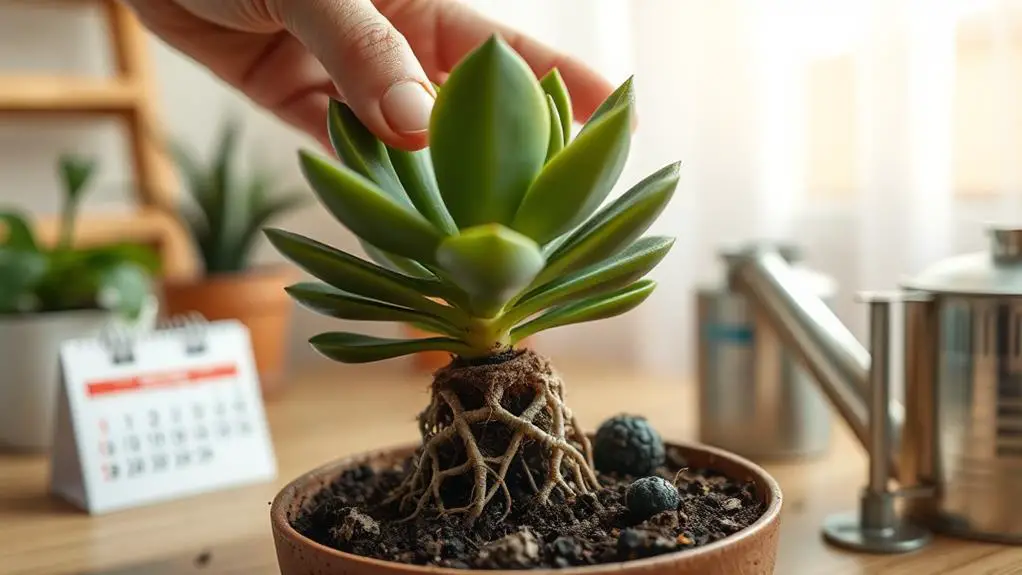
Once your succulent is repotted and lightly watered, it's important to monitor its recovery. Start by observing the plant for any signs of stress, such as wilting or leaf discoloration. These can indicate the need for additional care.
Make sure your succulent is in a spot with adequate light. This helps it recover and encourages new root growth.
Keep a close eye on the soil moisture. Overwatering can lead to root rot, while underwatering can hinder recovery. Let the soil dry out between waterings to find that perfect balance.
During the growing season, you should see new growth within a few weeks. This is a good sign that your succulent is on the mend.
Don't hesitate to engage with community resources or forums. Sharing your plant's progress and learning from others who've successfully managed post-trimming recovery can be very helpful.
You'll find that many people are enthusiastic to offer advice and support.
Frequently Asked Questions
How to Trim the Roots of Succulents?
To trim succulent roots, gently remove the plant, clean off old soil, and cut dead or tangled roots. Let the roots dry for 1-2 days before replanting in fresh soil. Monitor for stress signs afterward.
How and When to Prune Succulents?
You should prune succulents at the start of the growing season when they show signs of overgrowth or damage. Use clean, sharp tools to trim leggy stems and damaged leaves, promoting healthier and more compact growth.
Can You Cut the Roots of a Succulent and Replant It?
Sure, you can cut the roots of a succulent and replant it. Just make sure to trim only one-third of the roots, let them dry for 1-2 days, and then replant in fresh, well-draining soil.
How to Trim Succulents and Replant?
To trim succulents, gently remove them from their pots, brush off old soil, and cut away damaged roots. Let them air out for a day, then repot with fresh soil. Monitor them closely for recovery.
Conclusion
You've got this! By following these steps, you'll help your succulent thrive. Always check root health, use clean tools, and handle the plant gently. After trimming, let the roots dry and repot with well-draining soil. Keep an eye on your succulent as it recovers, and don't forget to water it properly. With a bit of care and attention, your succulent will bounce back stronger than ever. Happy gardening, and keep up the great work!


